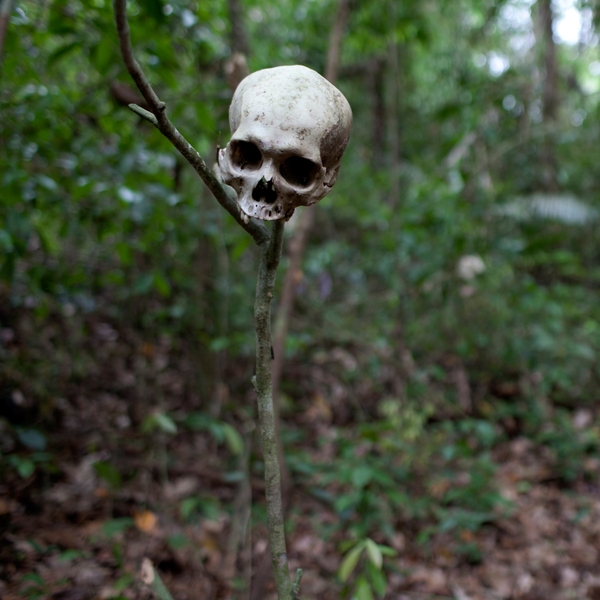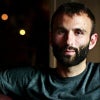A Terrifying Journey Through the World’s Most Dangerous Jungle
The Darién Gap is a lawless wilderness on the border of Colombia and Panama, teeming with everything from deadly snakes to antigovernment guerrillas. The region also sees a flow of migrants from Cuba, Africa, and Asia, whose desperation sends them on perilous journeys to the U.S. Jason Motlagh plunged in, risking robbery, kidnapping, and death to document one of the world’s most harrowing treks.
New perk: Easily find new routes and hidden gems, upcoming running events, and more near you. Your weekly Local Running Newsletter has everything you need to lace up! .
“Huelo chilingos,” the boatman shouts over the drone of an outboard motor. I smell migrants.
I turn around and see nothing but a wall of dark, unruly jungle, then I slump back into the bow of the canoe. Five days we’ve been out here, waiting for a group of foreigners to appear on this godforsaken smuggler’s route in the Darién Gap, and all we have to show for it is sunburn and trench foot. Our search is starting to feel futile.
For centuries the lure of the unknown has attracted explorers, scientists, criminals, and other dubious characters to the Gap, a 10,000-square-mile rectangle of swamp, mountains, and rainforest that spans both sides of the border between Colombia and Panama. Plenty of things here can kill you, from venomous snakes to murderous outlaws who want your money and equipment. We’ve come to find the most improbable travelers imaginable: migrants who, by choice, are passing through the Darién region from all over the world, in a round-about bid to reach the United States and secure refugee status.
As traditional pathways to the U.S. become more difficult, Cubans, Somalis, Syrians, Bangladeshis, Nepalis, and many more have been heading to South American countries and traveling north, moving overland up the Central American isthmus. The worst part of this journey is through the Gap. The entire expanse, a roadless maze that travelers usually negotiate on foot and in boats, is dominated by narco traffickers and Cuba-backed guerrillas who’ve been waging war on the government of Colombia since 1964. Hundreds of migrants enter each year; many never emerge, killed or abandoned by coyotes (migrant smugglers) on ghost trails.
Our attempted trip is possible only because we’re traveling with the permission of (FARC), the Marxist rebels who control access to the most direct line through the Gap—an unmarked, 50-mile, south-to-north route that’s also used to move weapons and cocaine. Following months of negotiations, FARC commanders based in Havana have agreed to let us attempt the trek and visit a guerrilla camp, so long as we keep the main focus on migration, not politics. After five decades of fighting, at a cost of more than 220,000 lives on both sides, FARC and the Colombian government are in the final stages of a peace deal that would end Latin America’s longest-running insurgency. No more complications are needed.
Having spent the better part of a week idle in Bijao—a ramshackle hamlet on Colombia’s Cacarica River, which a group of migrants is said to be approaching—we’re restless. So today we traveled three hours by boat to visit FARC rebels on an adjoining waterway. An entire morning was spent hacking through spider-infested mangrove swamps to reach their camp, only to be told that our scheduled interview is off because they don’t have their uniforms with them.
Interview with the Author
On the �����ԹϺ��� Podcast, editor-in-chief Chris Keyes talks to Motlagh about his trek through the Darién Gap.We are on our way back to the village, cursing our bad luck, when the boatman repeats himself.
“Huelo chilingos.”
“Bullshit,” I sigh.
“No, man, he’s right—I think I saw an elbow,” says , a Chilean photojournalist who’s traveling with me. Carlos, 50, has a knack for busting my balls at the worst moments, but he’s already standing up, camera in hand. Roger Arnold, a 48-year-old videographer I met in Afghanistan, who’s along to film our trip for a TV newsmagazine in Australia, is poised right beside him.
We round a bend and there they are: two Bangladeshis, bent over, sloshing forward in waterlogged rubber boots. They give us a nervous grin, thumbs up. Twenty yards ahead of them, a big, shirtless Colombian coyote is towing a canoe that contains another half-dozen migrants. Several Nepalis slog alongside.
I catch up to explain that we’re journalists, but none of the men speak much English. Nor do they believe what I’m telling them.
When I ask Arafat, a 20-year-old construction worker from the Noakhali district in southern Bangladesh, if his goal is to reach the United States, he shakes his head. “No, no. Tourist,” he says, patting his chest. “Problem?”
There’s no problem, I assure him as I approach the canoe, which is nearly scraping the bottom of the low-running river. Arafat’s friend Jafar leans back and laughs behind a pair of knockoff gold Ray-Bans. “Yeah, man!” he says. “Panama!” More thumbs up.
This tourist charade soon falls apart. A pudgy Bangladeshi man named Momir, his face ghoulishly pale from fever, rejects the coyote’s order to get out of the boat when it runs aground. Arafat shows us a large gash on the bottom of his foot and refuses to walk any farther. The men are weak from days of traveling in muggy, 90-degree temperatures, subsisting on crackers and gulping river water. And they are scared. For all they know, we’re Colombian authorities about to arrest them, or bush thugs ready to strip them of their remaining cash, stitched inside the lining of their pants.
The men are weak from days of traveling in muggy, 90-degree temperatures, subsisting on crackers and gulping river water. And they are scared. For all they know, we’re Colombian authorities about to arrest them, or bush thugs ready to strip them of their remaining cash.
Jafar starts to cry, triggering an outburst of desperate pleas from the men. They flash scars on their wrists and stomachs; one is missing part of a finger. “Bangladesh politics,” a man named Nazrul says ruefully as he drags a hand across his neck.
During a three-month stint reporting in Bangladesh in 2013, I became familiar with its cutthroat political gangs and dismal working conditions. Activists, journalists, and opposition members are often hacked to death in public. Rising water levels are drowning farmlands. Rural laborers flock to hyper-crowded cities for work and find themselves locked in the bowels of unlicensed garment factories, toiling for 20 cents an hour.
It’s easy to understand why any sane person would leave such grim prospects behind. Harder to grasp is how these men ended up on the southern edge of the Darién Gap, half a world away from home, without the faintest idea of the grueling trials ahead. Their willpower is amazing, but the Gap’s shadowy depths have swallowed travelers far more prepared. As we continue upriver together, it seems just as well that they are ignorant of the dangers.
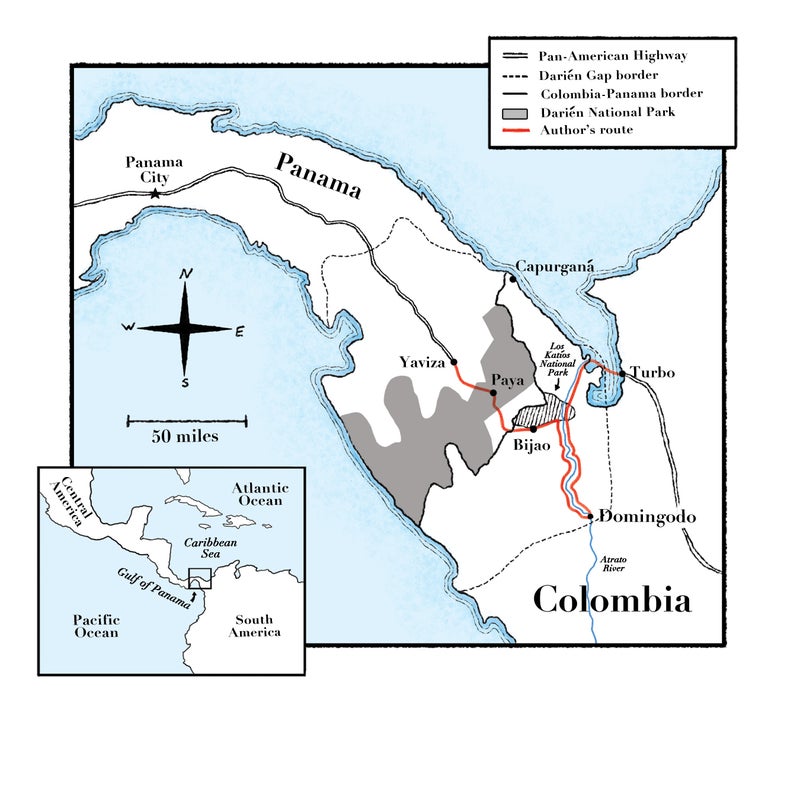
is a remarkable feat of engineering that runs about 19,000 miles from Prudhoe Bay, Alaska, to Ushuaia, Argentina, with just one break in the pavement: the Darién Gap. Also known as El Tapón (“the plug”), it can’t be bypassed on land. It’s roughly 100 miles wide, stretching all the way from the Caribbean Sea to the Pacific Ocean. It has long defied the advance of colonists, road builders, and would-be developers.
The Gap’s legend as a black zone is steeped in bloodshed and tragedy. After Spanish conquistadors discovered the region in 1501, they consolidated their first mainland colony in the Americas by slaughtering tens of thousands of natives, often by turning ravenous dogs loose on villages. The Spanish conquered the Amazon and the Andes but eventually gave up on taming the Gap, which became a bastion for pirates and runaway slaves. In 1699, more than 2,000 Scottish colonists perished from malaria and starvation, and in 1854 nine explorers died from disease and exposure on a U.S. Navy survey expedition, scuttling plans for a grand canal project through the isthmus. In more recent times, efforts to build a road link have foundered because of fears that foot-and-mouth disease could spread and devastate the U.S. beef industry, and because of resistance from the Kuna and Embera-Wounaan Indians who inhabit the rainforest.
The absence of any controlling authority in this wilderness has given free rein to armed groups. A military branch of FARC known as the 57th Front calls the shots around much of Colombia’s Chocó Department—a dirt-poor sliver of land in northwestern Colombia that overlaps the Gap and is one of the wettest places on earth—and often moves freely back and forth across the porous border with Panama, a vital transit area for arms shipments and the cocaine exports that fund its war chests.
In the early years of Colombia’s civil conflict, adventurers could still move through the Gap by foot, motorbike, or four-wheeler. The first vehicular crossing was achieved in 1960 by a Jeep and Land Rover expedition, at an average speed of 220 yards per hour over 136 days. George Meegan of England went even farther, getting shot at in the Gap during an unbroken trek across the Western Hemisphere that he started in 1977. In the eighties, a British adventure travel company offered multiweek treks through the Gap. But by the mid-nineties, the prevalence of armed groups led to a plague of kidnappings, disappearances, and murders that put an end to such trips.
In 2000, two Brits, Tom Hart Dyke and Paul Winder, were taken hostage by FARC guerrillas while searching for rare orchids. They were held for nine months and threatened with execution before being released unharmed. In 2003, Robert Young Pelton, author of , and two backpackers were held for more than a week by the United Self-Defense Forces of Colombia (AUC), the formally demobilized right-wing militia that was once the largest paramilitary group in the country. In 2013, Jan Philip Braunisch, a Swedish traveler attempting to cross the Gap alone via the Cacarica River—our planned route—vanished in FARC territory. It later emerged that he was killed by a shot to the head.
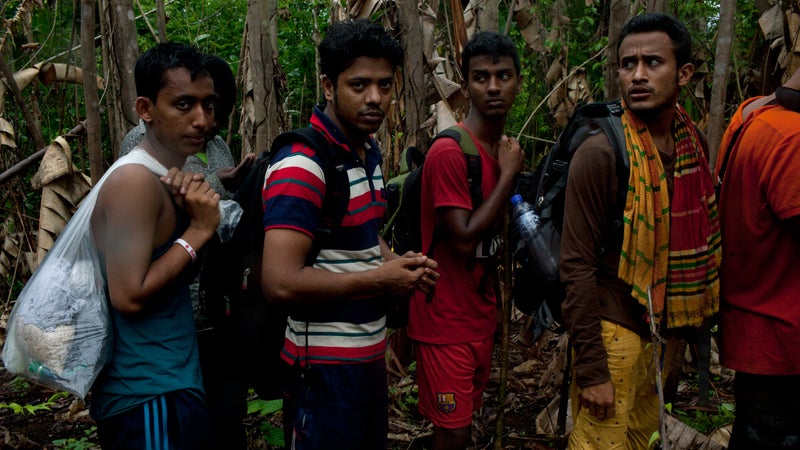
Since the late aughts, U.S. authorities say, FARC has increasingly relied on the Darién corridor to smuggle drugs north as traditional air and sea routes have been clipped. Fierce competition for massive drug profits has also fueled the rise of neo-paramilitary groups that terrorize the region with wanton killings and armed assaults. The most powerful is the Clan Úsuga, a.k.a. Los Urabeños, a vicious gang made up of ex-AUC members. Seizing control of lucrative routes along the Caribbean coast, Los Urabeños has used its links with Mexico’s Sinaloa cartel to expand its presence around the country and challenge FARC in parts of Chocó.
When migrants began turning up near the border, both groups started using well-worn drug-smuggling routes to move human traffic for money. Over the past ten years, this flow has swelled to a steady stream as the standard maneuvers for reaching or rooting in the U.S., like overstaying a visa, have become tougher to execute. Cubans, lured by the promise of political asylum upon hitting American soil, account for most of the migrant flow, preferring the lesser known path through Central America to the familiar perils of the Florida Straits. But they are rivaled by a rising tide of Haitians, Somalis, West Africans, and South Asians.
Though it’s impossible to know the precise numbers, Panama saw 25,000 illegal arrivals last year, more than three times the number that came through in 2014. (Of these, about 20,300 were Cubans.) By late May of this year, another 8,000 migrants had passed through the Gap.
The fact that so many people would undertake such a long-shot journey caught my eye and Carlos’s well before we knew each other. Back in 2006, he was reading a newspaper in Bogotá when he saw a story buried in the back pages: a boatload of Chinese migrants had been captured in the Gap. During one of the half-dozen trips Carlos has since made in the region, he came upon the decomposing body of a Cuban migrant on a jungle trail. On another, he was stunned to pass a boat full of Somalis and Bangladeshis on the Cacarica. Smugglers ultimately turned him back, but the incongruous scene lingered in his head.
An had the same effect on me. It described how growing numbers of U.S.-bound migrants are flying or taking cargo vessels to Brazil and Ecuador, countries with lax visa and asylum requirements, then heading overland to Colombia on backcountry buses. Those with the means and a passport hire boats to bypass the jungle and reach Panama by sea; the rest take their chances running the Gap. In Panama they’re detained for background checks. So long as their names don’t turn up on international terror watch lists—which I was told has never happened—they are released to keep heading north.
These migrants are a fraction of the more than 65 million people that the United Nations estimates are now in flight because of war, persecution, and terror, the largest such displacement in human history. There are refugees in peril all over the world: Syrians seeking safe haven in Turkey, West Africans traversing the Sahara en route to Europe. But the Darién Gap is the global migration story in extremis. What could possibly possess someone to enter it?
The Gap’s legend as a black zone is steeped in bloodshed and tragedy. After Spanish conquistadors discovered the region in 1501, they consolidated their first mainland colony by slaughtering tens of thousands of natives, often by turning ravenous dogs loose on villages.
By land or sea, the main jumping-off point for crossings into Panama is Turbo, a dodgy Colombian port town on the Gulf of Urabá that has a bad reputation for violence. Once a FARC stronghold, Turbo became a battleground in the late 1980s when paramilitaries took over. We had been scheduled to travel there in early April, but we had to delay when Los Urabeños, excluded from peace talks with the government, called for a 24-hour strike to show that it still runs this part of the country. All public transport and shops shut down; streets emptied. Three policemen and an army captain were shot dead, presumably after the gang announced a reward for killing authorities. A group of traffic cops were injured by a grenade.
A month later, on May 6, we checked in at our residencia on a balmy morning. From a balcony overlooking a shaded plaza that has hosted many a drunken machete fight, I watched fishermen mend their nets while others played cards. Horse-drawn flatbed trailers bearing grains and bananas—the region’s chief legal cash crop—whipped by in a flurry of hooves. Turbo, the northern terminus of the Pan-American Highway in South America, is home primarily to darker-skinned Afro-Colombians, descendants of slaves brought to work in agriculture and mining in the 1500s. I didn’t see any migrants among them.
Lying in a hammock, with two German shepherds nestled at his feet, the motel’s manager, Juan Montero, explained that Urabeño smugglers usually charge between $500 and $700 to shuttle a migrant from here to Panama, a five-hour trip in a leaky boat. Alternatively, some migrants opt for a harder, cheaper inland route that starts at the coastal town of Capurganá or Sapzurro and goes through a series of hamlets that dot Darién National Park, which covers a large part of the central and west side of the Gap. Because there is no Colombian border facility nearby where captured migrants could be sent, Panamanian authorities have typically allowed them to pass.
One week before our arrival, however, the immigration office in Turbo began granting migrants exit papers to bring the traffic aboveground. Now they could openly buy boat tickets to Capurganá and Sapzurro. From there it’s a short boat connection or hike to La Miel, in Panama. Those without documentation might still hire coyotes to take them up the longer jungle route, which is also a major Urabeño drug-trafficking path. The gang is known to forcibly conscript migrants as mules—and sometimes dispose of them.
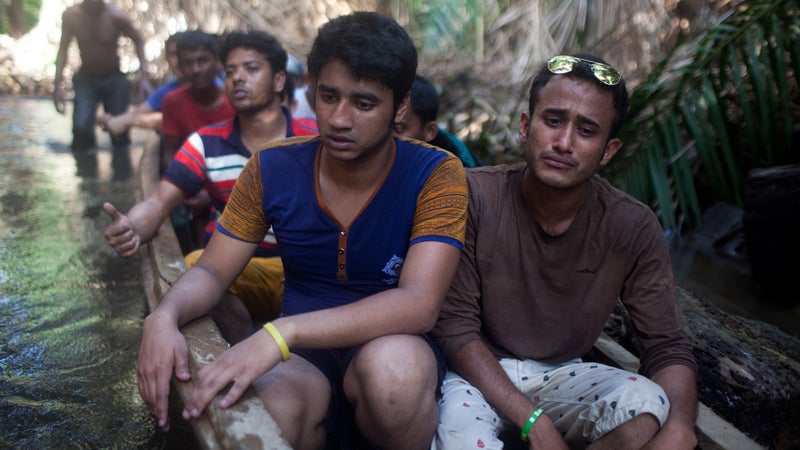
At a moss-cloaked graveyard on the edge of Turbo, several tombs were scrawled with “N.N.” (no name), in drab contrast to the colorful encomiums locals left for loved ones. Montero told me that most of the dead were Somalis who had been robbed and tossed overboard by ruthless coyotes. On a 2014 trip to Acandí, an Urabeño-dominated town across the gulf from Turbo, Carlos had photographed the tomb of Roberto Tremble, a 33-year-old Cuban murdered by smugglers.
Cubans still accounted for most of the migrants, Montero said. “Many doctors,” he noted. Until recently, they flew to Ecuador, one of the few countries that have no visa requirement for tourist stays. But Ecuador had changed its policy, and Cubans were now coming in waves from Guyana, which was their last legal beachhead in South America.
In a video shot on Montero’s smartphone, Miguel, a ropy old Habanero, touted Cuba’s free health care and education but grumbled that his salary was not enough to buy shoes. “We are a country bounded by water and we don’t have enough fish for the people,” he fumed. “Populist socialism is terrible.”
Another Montero video showed a group of Nepalis hunched over paper plates in the same room we were now in. Authorities had caught them and brought them to Montero’s for a meal before deportation. “Of course, I never called customs on any of the ones who stayed here, because I don’t agree that those looking for a better life should be sent back,” Montero said. “Their motivation is incredible.”
Montero’s place was currently empty of migrants, so he directed us to the Hotel Goodnight, a flophouse located several blocks away, past bars and pool halls full of guys who threw us bloodshot stares. In the second-floor lobby, I found two Haitian teenagers thumbing WhatsApp on their phones. I introduced myself. One immediately exited down the hallway; the other refused to look up.
A third man was smoking on the balcony. He told me his name was Jackson Wilner and that he was a mason from Cap Haitien looking for work in Turbo. When I pressed him on how he planned to get to Panama, he stuck to his script. On my way out, I noticed that the door to his room was ajar. Looking in, I saw four people lying on a single bed. Three more were asleep on the floor.
Before dawn the next morning, we headed down to the docks. A boat was leaving for Capurganá, and Montero was sure it would draw migrants into the open. He was right. In the dim light, I could see men milling around. They turned out to be Haitians, Nepalis, and Pakistanis.
Zia ul-Haq, who I talked to on the dock, was the lone Afghan in the group. Twenty-six and slender, with thick brows hanging over forlorn eyes, he told me in halting English that he learned the language by watching bootleg DVDs: the Fast and Furious series was a favorite. He hailed from Nuristan, a remote, beautiful, and violent pocket of mountain ridges plied by fierce tribesmen. Zia’s uncle worked as a translator for U.S. forces, and the family moved to Kabul when Taliban death threats intensified. His uncle was eventually relocated to the United States. Zia applied twice for a visa to follow him, without luck. “Day by day it was getting worse, so I took this journey,” he said. “If someone’s life is in danger, they will do everything for themselves.”
Dubai. São Paulo and the Brazilian Amazon. Peru. Ecuador. Colombia. For the past two weeks, Zia had been dodging police shakedowns, riding back roads in chicken trucks, slipping across borders after dark. From here he would head by boat to Capurganá and then Panama or walk through the jungle; he’d heard the hike was anywhere from two to four days. He confessed to having no idea how to navigate the minefield of gangs, authorities, and six borders that would still lie between him and the U.S.
His provisions: cookies, energy drinks, and $90 in cash. He’d spent more than $1,500, paying for one leg of the trip at a time, to get this far. For protection he carried a booklet of Koranic verse in his front pocket. Zia’s goal was to join his uncle in Las Vegas and one day enroll in medical school. “The U.S. is a safe country,” he said. “They love peace, so we are trying to get there.”
I reminded him that anti-immigrant sentiments were rising in the U.S. Was he worried he might not be welcome?
“It’s a long way still,” he said after thinking it over. “Maybe the Americans have their limits. But there is no way of knowing.” He paused. “I just want a good life. No more feeling scared.”
By 9 A.M., with the equatorial sun arcing overhead, there was a hum of fellow travelers and commerce. I spotted Jackson, the Haitian from the hotel, clutching a black trash bag that contained all his belongings. He was with the two teenagers, and they all avoided making eye contact with me. Hawkers were peddling ponchos and Chinese-made headlamps for $5 a pop beneath a sign from the municipal tourism board that read: Buen Viaje! Have a good trip!
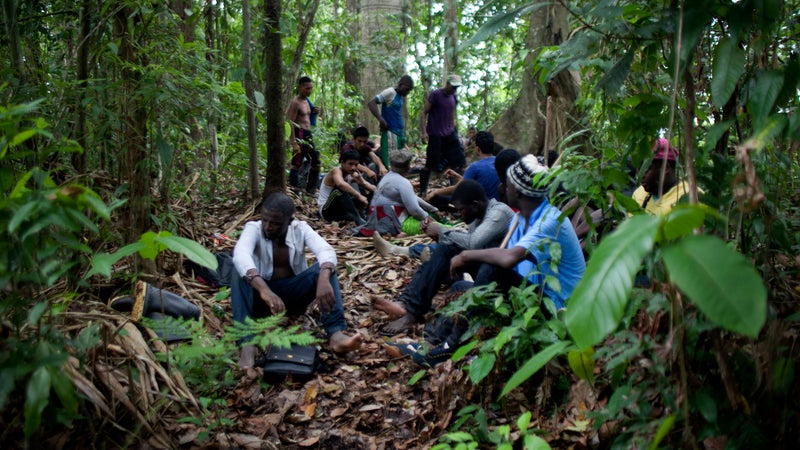
A large motorboat arrived; names were called and life vests distributed. I gave Zia my card and shook his hand. “Get in touch when you make it to Vegas,” I said. Squeezed in among the migrants were backpackers from England, Australia, Japan, and Brazil, who would soon be drinking coconut cocktails on the same beaches that some of these refugees would tramp across.
From the edge of the dock, I watched the boat rumble into the channel. Some of the travelers were snapping selfies. The Nepalis waved. Zia did not look up. He was holding his Islamic traveler’s booklet in his palms, head bowed, asking for protection.
Jairo carries a sweat towel around his neck stitched with Comando de Muerte (“death commando”) under a skull and dagger. It belonged to a Colombian soldier, he says, adding, “It was not a gift.”
The next day we met “Angela,” an emissary sent by the FARC bosses in Havana. She was in her mid-twenties and had heralded her arrival by texting suggestive pictures of herself. Sucking a lollipop, she told us we had to travel to a town a half-day up the Atrato to meet our primary rebel contact in the Chocó—her father, Elber. We were assured the route was OK, though we would have to pass army checkpoints and Urabeño strongholds along the way.
Choppy seas on the open gulf sent our panga skipping and diving through sheets of salt spray. At the first of two military stops, Colombian soldiers questioned locals headed to inland villages and outbound Cubans with exit papers. We turned southwest and the water narrowed into the Atrato, whose vast wetlands comprise half of Los Katíos National Park, a Unesco World Heritage site. Birds-of-paradise tumbled down its banks and birds of prey soared above us. In the near distance, rain clouds bearded the jungle-clad hills that marked the frontier. While efforts by authorities to combat illegal logging and overfishing have removed the park from the UN’s list of endangered natural places, visitors are scarce. Chocó is Colombia’s poorest department, with a high-stakes drug trade that has FARC and the paras clashing over key routes that run off the river highway.
At the aptly named Riosucio (“dirty river”), we switched to a smaller canoe manned by tough-looking guys with facial tattoos. It was another hour to our destination, Domingodo, a dead-end village where we would spend the next three days making arrangements for our foray into the heart of the Darién Gap. A mestizo woman was hacking open tortoises for stew; pigs rooted around for scraps in muddy alleyways. From end to end, shack-rattling salsa thumps blasted from bar speakers that never went silent, day or night.
Our host, 50-year-old Elber, wore athletic shorts and carried no weapons, but he was FARC to the core. Burly yet soft-spoken, Elber has served as a political operative for three decades in the dispossessed, largely black communities of the Chocó. Early one morning, he invited us to a “political” meeting at a derelict sawmill in the midst of banana palms and sugarcane fields. Industrial saws were rusting away, half-covered, on a rotted platform. The sawmill was opened in the early 2000s, with government funding, as an alternative to coca trafficking, but support ran dry. No one knew how to operate the machinery, a failure of top-down planning that Elber said was emblematic of government neglect in the Chocó. He presented a case to those assembled for reviving the mill, but swarming mosquitoes made listening too difficult.
Later that afternoon, Elber announced that the commander of the 57th Front, Pablo Atrato, was ready to receive us at his hideout, another half-day up the river. With FARC slated to begin disarming in the coming months, this was a timely opportunity to discuss the tricky business of peace. In the 1990s, a nascent hard-left political party called the Patriotic Union was ravaged by paramilitary death squads allied with government security forces. More than 4,000 members and supporters were killed, including two presidential candidates. FARC’s command has repeatedly delayed the process to avoid the same fate.
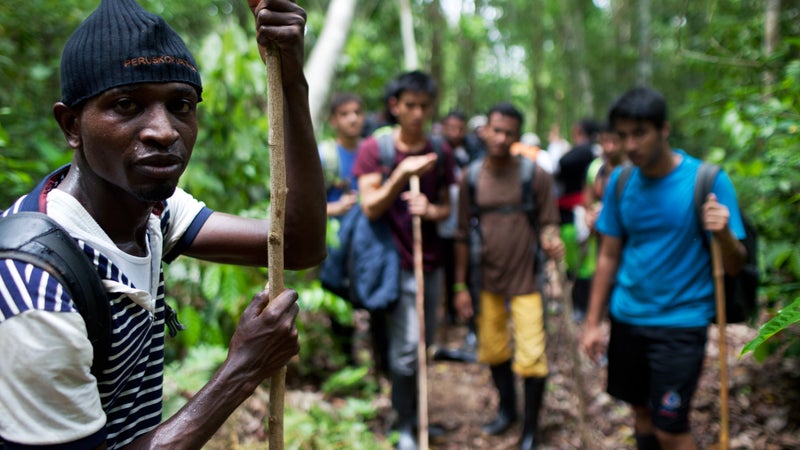
Meanwhile, we had a new concern: on May 9, Panama abruptly closed its border with Colombia to stem the flow of migrants. We were hearing that people in transit to the U.S. were being turned back in droves along the Caribbean coast. The odds were that they would have to push deeper into the Gap and then turn north, making them difficult to find. We climbed into our canoe and set course for Bijao, a traditional junction for migrants on the Cacarica River.
A late start forced us to overnight in Puente America, where a bartender told us that no migrants had come through in weeks. But in a vacant schoolhouse by the water, we found a gallery of graffiti. Rahim from Pakistan had been here, along with Ahmed from Ethiopia and Yahya from Kenya. The walls were scrawled with national pride and nostalgia for home. “Ghana 50 Cent and his group moving to USA.” “God help us, we are on the way to USA.” “God bless Sierra Leone.” “Enjoy the journey.”
Turning up the Cacarica later that morning, the Atrato’s big sky was replaced by dense canopy that spotlighted a fetid marshland of gnarled roots and cativo trees. Rafts of rosewood timber attested to the illegal logging operations common to the rebel-held area. The water was just a foot deep in places, forcing us to get out and push. Farther along, a stash of fresh Aguila beer crates sat on a bank, unguarded. We glided past a sign for Los Katíos fronting an abandoned visitor’s bungalow. Everyone was on edge.
A Perilous Crossing
In September, the Australian newsmagazine “” will air an hour-long segment on Jason Motlagh’s expedition through the Darién Gap, using footage shot by Motlagh and videographer Roger Arnold. Here’s a preview.
“I’m not getting out of the fucking boat until I’m invited,” Carlos intones as we glide into Bijao village, under the gaze of naked children. We all hang back as Elber strides up the bank and greets a handsome, middle-aged black man in a tank top. We’re waved over and introduced to John Jairo, the platoon leader of the FARC guerrillas patrolling this area. With Elber vouching for us, it doesn’t matter that they were unaware of our planned visit. Word from Havana about us had not trickled all the way down the command chain.
The guerrillas are overnighting in Bijao, which is unusual. They wear plain clothes, their assault rifles stashed inside the crooked wooden homes that line the village, but it’s not hard to single them out. Close-cropped haircuts for the men; high, tight hair buns for the women. They all steer clear of us.
After we’re taken to our lodging, a blue and white structure built by the UN’s refugee agency, with a No Armas sign posted at the entrance, Elices Ramirez, the smooth-talking village representative, tells me that the guerrillas are accepted by locals, who harbor a deep mistrust for a central government in Bogotá that exists for them only in name. “They have done nothing for us,” he says. The local school sits shuttered, and with the nearest medical clinic in Turbo, a day’s journey by boat, people die of treatable illnesses like malaria and nonlethal injuries. Contraband smuggling—drugs, goods, chilingos—is rife in the area, he admits, but “we do our best to maintain order.”
Wandering around the warrens of raised shacks and dry-goods stalls that afternoon, I spot Elber standing at the center of a public gathering, calling for “justice without prejudice.” Apparently, two men had gotten into a drunken fight, and one of them nearly took off the other’s arm with a blade. An impromptu tribunal has convened to decide the man’s fate, and most of Bijao is in attendance. The accused is ultimately expelled from town by majority vote, with a warning to never return.
After dinner we’re invited to sit down with Elber and the FARC officers. I pass out cigarettes and Carlos starts to chat them up, name-dropping the commanders he knows and explaining our goal of tracking migrants. Jairo and his light-skinned deputy, Haiber, listen, motionless. I can’t read their expressions in the darkness, but their intensity is palpable.
“I have a question for you,” Haiber finally interjects, pausing for effect. “What is the meaning of chilingos?”
Laughter. No one has a clue where this slang term for migrants came from. I seize the opening to ask how long they have been guerrillas and why. Jairo, 39, says he joined at age 11, after feeling powerless watching his father labor in the fields for years with nothing to show for it but an early death. “We didn’t have a school in the community, and we couldn’t afford a pen and paper anyway,” he tells me. “I felt compelled to rise up against the corrupt state. They don’t respect you unless you fight them.”
Jairo carries a sweat towel around his neck stitched with Comando de Muerte (“death commando”) under a skull and dagger. It belonged to a government soldier, he says, adding, “It was not a gift.”
By the end of our talk, Jairo says we’re free to travel through the Gap with FARC support. No escort or formal letter of approval will be given to us. It is simply understood that we are vouched for by the guerrillas, so we are not to be fucked with. In any case, by morning the fighters would leave Bijao to “go to work.” The Urabeños were starting gun battles on another stretch of river in their latest bid to chisel their way into FARC territory.
In late February 1997, fighters with the Élmer Cárdenas bloc, a hardcore right-wing unit, launched bombs into Bijao as part of a government-led operation that sent thousands running into the bush. Marino López Mena, a local man, was captured and decapitated, his head used as a ball in a soccer game. Another boy who was captured was tied to a tree and made to watch the gruesome spectacle; he still lives in Bijao, left incoherent by mental problems.
It’s a swelteringly hot morning, and Elices walks me to the homemade memorial by the river. He fled along with his neighbors, children in tow, traveling four days across the Gap to Panama, joining the 20,000 people that he estimates were displaced from other villages swept up in the violence. Most, he says, have returned to resettle acreage that is theirs under Law 70, a 1993 ruling that granted black Colombians collective ownership of ancestral lands. But they are still wary of the threat posed by the paras and a state with a record of abetting violence.
Has Bijao’s history of war and displacement made locals more sympathetic to the migrants coming through? “Absolutely—we understand their situation, for we went through the same experience,” Elices says. “We do this as brothers, for we believe everyone has the right to live. We offer our support not because we want to make any money. It is a humanitarian action, our way to help them survive, the same way we were helped.”
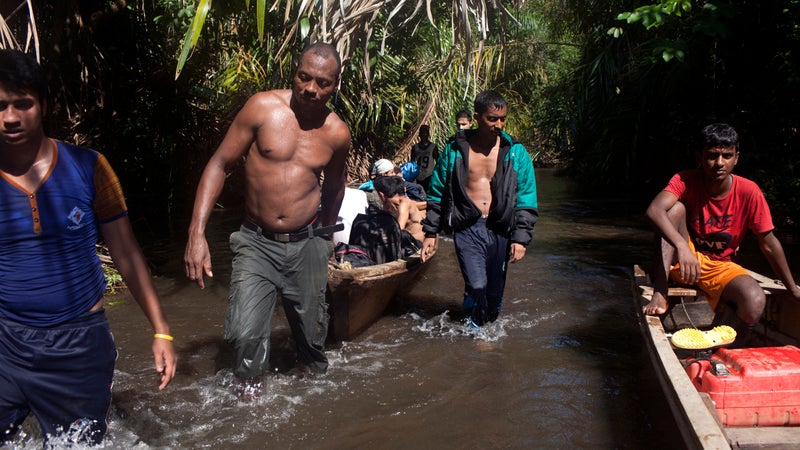
When the Bengalis and Nepalis we found on the river finally do pull into Bijao to join us, a band of young hustlers is waiting on the bank, ready for business. Ten bucks for a night in the barracks where we’re staying, mosquito net included. Plus another $5 for a plate of eggs, beans, and rice. The migrants claim that they have no money but soon give in. They are adding their own names to the graffiti-covered walls, buoyed by proof that so many countrymen have been here before them, when word comes in that there’s a mango tree nearby loaded with ripe fruit. The room empties; outside, rocks and sticks start to fly. Jafar picks up two mangos, triumphant. Arafat seems to have lost the limp that was ailing him on the river. “Same like Bangladesh,” he beams, juice dripping down his chin.
Arafat says his journey began when friends back home introduced him to a broker, who he paid more than $10,000. A Brazil visa and a flight to São Paulo were arranged, with a stopover in Doha, Qatar. From there he made arrangements to travel through Bolivia, Peru, Ecuador, and Colombia, where he and a group he was traveling with got mugged by police.
Unknown to us, a second boat full of nine West Africans also departed from Puente America the previous night and has fallen in behind the Bengalis. When I return to the barracks after dark, five Cameroonians in alpaca-wool hats and two Togolese men are sprawled on the hardwood floor. A pair of Gambians, Ebrima Jobe and Morro Kanteh, are recovering on the porch.
“Fucking hell,” says Ebrima, the taller one, when I ask about the trip. He means the past 24 hours, when he had to cross the river at night and trudge on foot through the swamp. But his entire three-week journey has been a breathless flight from death.
For more than two decades, Gambia, a narrow country on the West African coast, has been ruled by a dictator who silences all dissent with brute force. In mid-April, a police crackdown on protesters demanding electoral reforms saw three men die in custody, including a leader of the main opposition party. This man was Ebrima’s mentor, and Ebrima, 38, heard that his name was on the hit list. With help from friends, he left his pregnant wife and two children for Dakar, then caught a flight to Madrid and from there flew to visa-free Ecuador, where he planned to apply for political asylum. On the go, he kept in touch with his family by e-mail. They were safely holed up with relatives, but he could never rest easy.
Bureaucratic snafus moved him to try for asylum again in Bogotá, to no avail. So he turned his sights to the U.S. and bused to Turbo. “Now I just want to get out of here,” he tells me. “Colombia is no good.” I ask if he’s heard of the Darién Gap and he shakes his head. I describe it and he becomes somber for a moment, aware that the worst is still to come. “We will cross together,” I say, and Ebrima joins his fellows on the floor.
Our dawn departure is delayed by a dispute. The Africans roundly insist that they paid the coyotes in Turbo a flat fee to take them all the way to the Panama border; the Bijao hustlers counter that they are owed more. The migrants have no leverage out here, and the impasse ends when each migrant ponies up an extra $20. We aren’t spared, either. John and Alberto, the two porters we hired to help with our gear, are now demanding three times the agreed-upon sum—roughly $300 each.
“These people are capitalists, they make money from our misery,” Morro says later that day, as we head upriver in a sagging canoe. “I’m sick of this place.” Like Ebrima, his role as a youth leader in the Gambian opposition compelled him to flee. He scans the jungle for a while, then catches me off guard.
“Why are you here?” he asks.
I give him a boilerplate answer, but in the moment it feels hollow, even frivolous. For all my good intentions, I’m still a Western journalist getting paid to do this. What I don’t say is that my privilege was secured by the audacity of an Iran-born father who made his own long-shot gamble to reach the United States.
Back when I was a 25-year-old freelancer striking out for Africa, my father, Homayoun, drove me from Washington, D.C., to New York City to see me off at JFK. I’d always assumed he’d emigrated the way normal people do, but in the departure lounge he told me that he had been unable to secure a visa in London, where he was studying in 1973, despite having family members stateside, at a time when trouble was brewing back home in Iran. So he booked a flight to Toronto, with a brief stopover in New York. As the plane neared JFK, he feigned violent illness; flight attendants hauled him off the jet. As he was being transported to a nearby clinic, he jumped out of the vehicle and into a car his brothers had sent to pick him up. Five hours later, he was eating kabobs in Washington, D.C. He carved out a living selling used cars, and he still works long hours on cold back lots. His gamble bought me a youth free of the Islamic Revolution and mandatory army service. I attended good public schools, played baseball, and graduated from college debt-free. Now I could buy a one-way ticket to the Third World with a sure return. It was the start of a wide-ranging journey that ultimately led me to this remote river, into the void.
We disembark two hours later at the Wounaan village of Juimphuboor. I’ve never found it on any map. Women pound laundry by the water, flanked by clutches of round, thatch-roofed huts that slope up the mountainside to slash-and-burn plots. Carlos tells us to keep our cameras off and our mouths shut: those same heights were likely the last place that the Swedish traveler Braunisch saw during his fatal 2013 attempt to cross the Gap.
In 2015, nearly two years after the 26-year-old went missing, the International Committee of the Red Cross delivered his skeletal remains to state investigators. FARC later took responsibility for his death, accusing him of having been a foreign spy, partly because he was carrying a GPS and had no prior approval to travel. His bad luck was compounded by bad timing: rebels and government forces were battling it out around the lower Atrato River, and a cease-fire with Los Urabeños had collapsed.
Three years on, peace talks between FARC and the government present us with an opening, but drug profits have a way of breeding spoilers in the Gap, and we are unusually fat targets. In addition to our expensive camera gear, battery packs, laptops, medical kit, and communications equipment, including a sat phone and GPS, we also have lots of cash. This is a pay-as-you-go venture, and the only way out is through.
One by one, our party—20 migrants, four porter-guides—shimmy under a barbed-wire fence and into the hissing maw of jungle toward our first objective: Palo de Letras, an unmanned crossing at the crest of a mountain, which will take at least ten hours of trekking to reach. The beaten path is lined with Red Bull cans, salt packets, and the first pieces of clothing discarded in the heat. I notice a long skein of leaf-cutter ants running fragments, parallel to our foot traffic. Their solidarity casts a sharp contrast to ours, which is starting to unravel.
It’s not yet noon when we stop to rest. Momir, the overweight Bangladeshi, is on the ground pleading with our guides to carry his bag for $10. “Please take,” he groans, doubling his offer to $20. But there are no volunteers, only indifferent looks. “Throw your things away,” one of the Nepalis says with a barbed edge. Reluctantly, Momir pulls out some tissues, then a T-shirt, then some socks and mittens. Morro grabs them and puts them on.
I have an urge to strip. My clothes are soaked through, my fancy knee-high, French-made boots freighted with water. The air is almost thick enough to chew. For a boost, I stuff a plug of dried coca leaves into my cheek with a chunk of quicklime. The concoction tastes vaguely of yerba mate and provides a jolt of energy and focus that will help me navigate the endless hills and switchbacks, mud-slick ravines, and root systems that obstruct our path. I can’t help but think of Steve McQueen in , a favorite of mine. When he is chased after escaping from a penal colony in French Guiana and starts falling behind, a timely wad of coca proffered by his native escort gives him the second wind he needs.
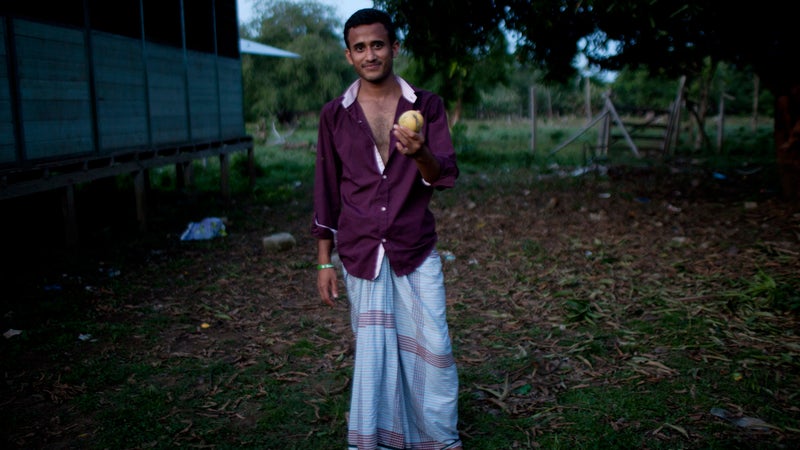
Cevedao, our Wounaan lead guide and porter, sets the pace of a mountain goat. We hired him and another man in Juimphuboor to help with our gear and see us through to the Paya River in Panama, since indigenous people can pass freely on both sides of the border. (Our porters from Bijao, John and Alberto, are taking a well-paid gamble crossing the border anywhere near migrants, because this carries a minimum five-year prison sentence.) Morro is close on his heels, followed by the Nepalis, who stick together and move at a steady clip. The Bengalis and Africans bring up the rear.
It’s not long before Evelyn Chantal, the only woman in our party, is flat on her back gasping for air. “This is too much. But what can I do with a war going on in Cameroon and Boko Haram killing all of our brothers?” she tells me once her breath calms. A hairdresser from a restive corner of northwest Cameroon, Evelyn left home as radical militants, expelled from Nigeria, threatened to overrun her village. With gold hoop earrings, lime spandex, and a backward courier cap, her flair has endured. But she is top-heavy, saddled with huge breasts, and wearing flimsy shoes, which she tosses aside.
“I’ve never moved in this type of forest, even in Africa,” she says. “I’m very, very scared, but I have no choice. I have to struggle because I want to save my life.”
Near dusk we learn that our native porter has vanished with Ebrima’s backpack, which contains his only change of clothes, money, and ID. After some tense discussion, Cevedao, with my encouragement, agrees to go back and find the bag. Only after he leaves does it dawn on me that in addition to our 30-pound backpacks, one of us would have to carry the 50-pound duffel stuffed with video gear and supplies. Because I’m the only man in my group without camera duties, this falls on me.
The trail by now is littered with more precious items: jeans, blazers, backpacks. I see a random discarded letter with runny scribbles and stuff it in my pocket. With each step, the muck is pulling harder on my boots. A gathering night riot of mosquitoes get their fill of blood, and the infernal heat sucks us dry. The jungle trail, I realize, is one big alimentary canal that breaks down everything that passes through. Thickets of thorns slice my arms; a series of fallen trees forces me to crawl on all fours. This is what you get for sticking your neck out, I think to myself. Head down, chin dug into the pack on my stomach, I stumble on.
“Did you see the skull?”
I’m lying in a shallow creek trying to cool my body temperature when Roger, our videographer, drops the news: in my stupor, I’d somehow walked right past a human head on a stake. Carlos missed it, too. We walk a quarter-mile back up the trail and it’s facing us—and Panama—presumably as a warning to anyone who would dare enter FARC territory. The surface is rain-polished to a shine, the jawbone missing.
“I swear I’ve seen this in a dream, man,” Carlos says, creeping closer, wide-eyed. “This is crazy.” We snap pictures and catch up with the group, driven by energy that no coca or caffeine had previously mustered.
Three hours later, we stop to make camp. The Bangladeshis swarm around me for insect repellent. The Nepalis bathe in their underwear and complain that the Bangladeshis complain too much and don’t share. The West Africans collect banana leaves for makeshift mattresses by the fire, which they feed with moss to create as much of a smoke screen against the mosquitoes as possible. Fruit bats bank and dive around them. By morning one man is hiding up in a tree.
The hangover of a rough night is tempered by the border crossing. At 10 A.M. we reach the stone obelisk that marks Palo de Letras, on the boundary with Panama. Those with working cell phones take pictures to remember the moment. Ebrima and Morro sit down to collect themselves, grateful to be out of Colombia at last.
“My faith keeps me moving, that’s it,” says Ebrima. “There is no turning back for me. I can’t go back to where I’m from.”
Meanwhile our shifty guides John and Alberto are anxious to head back home to Bijao. Although we had a deal to travel together to the Paya River, another half-day’s walk, they would face jail time if caught in the company of migrants by Senafront, the Panamanian forces that stalk the borderlands. They’re demanding to be paid in full, and more, to go all the way.
My temper flares. I never really trusted these men; paying them out would give up the last shred of leverage we have. But Carlos explains that we still need them to find our way, and we can’t afford to piss them off since they are skilled with machetes. FARC’s protection extends only so far.
I settle down, and a compromise is reached: the migrants will go ahead of us, on their own, to maintain a safe distance in the event that we’re intercepted. In English, then in French, I explain our predicament to the group and assure them that the route is easy to follow. Panama has a reputation for its humane treatment of illegals emerging from the jungle, complete with room and board. Everyone seems relieved at the prospect of imminent salvation.
But forward momentum is running down. During the next stretch, I spot a poured-concrete marker for the Carretera del Darien, a through-highway that was never built. Carlos sees a wheel from a Chevrolet Corvair, casualty of a 1961 expedition. Despite an hour’s head start, we catch up to the group. We sit and wait again. Same result. Somewhere in the skies above the canopy, rotor thumps from a Senafront helicopter are audible. Our panicked guides insist on moving ahead at double speed to drop the gear at the river, and I volunteer to go with them. We shoot up the trail, Cevedao in front, John right on my heels “for motivation,” until a merciful stop for water. I bend down to fill my canteen. They vanish.
I race to catch up but don’t see a trace. I call out their names. Nothing. At a fork in the path, I bear right and find an energy-drink can, but I’m starting to have doubts that I’m going the correct way. The Gap is veined with dozens of trails and detours to nowhere, and my GPS device lost its signal the day before. For all I know, I could be heading back to Colombia, a dreadful thought. I wonder, have the guides stolen our bags? Perhaps they are preparing an ambush. Did I go too far?
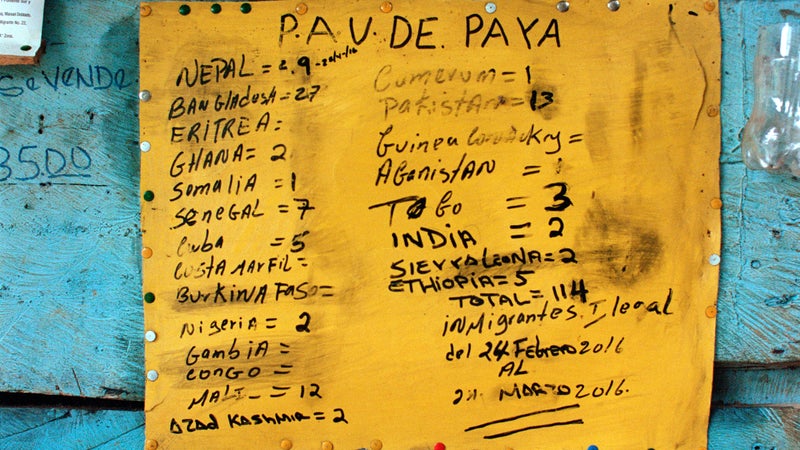
I arrive at a tepee-shaped structure that looks to be a marker and shout into the abyss for a while, with no reply. It’s then that I notice that the structure is a tripod-shaped root, not man-made. I can feel the veins pulsing in my forehead, the fury of being left behind cut by sudden alarm. I am retracing my steps to the junction I passed earlier, unsure of my judgment, when the rustle of leaves stops me in my tracks. One of the Togolese men appears down the trail in his brown winter coat. He mumbles something in French, and I can scarcely contain my relief.
When we finally catch up to the guides, I want to explode. But Cevedao is holding a finger to his mouth. Soldiers are on a hilltop not far down the trail, he says, and the Paya River is no more than 40 minutes away, tops. The guides dump our bags, collect the last of our pesos, and rush away as the rest of the group stagger in. One by one, they crumple to the ground; some are asleep within seconds. Evelyn is the worst off, her swollen toes protruding from socks torn to shreds, lips quivering in sweat. I try to get everyone’s full names and e-mail addresses in case they’re detained, but few can manage the pen. Roused for a final push, we wait as the migrants pick up what’s left of their things and vanish over the ridge.
Four hours later, Carlos, Roger, and I are still walking. The trail is relatively easy to follow, but the terrain is steeper. The heat and humidity are dehydrating our bodies, and our water supply is dwindling, with no fresh sources since the guides departed. Carlos struggles to keep up. The added burden of carrying all our gear is taking its toll, forcing us to stop at shorter intervals, until we finally run out of water. We have no idea where we are.
I go forward alone, clumsy and parched. Another hour or two passes, and the foliage around me becomes more lushly tropical. I’m barreling downhill through a tight chute of banana leaves that spit me out into a clearing where Senafront soldiers with M4 rifles are barking orders. Drop your bags and put your hands up! For the first time in my life, I’m relieved to face the barrel of a gun.
Our migrant friends are seated in rows on the ground, under armed guard, waiting. As I’m escorted into the soldiers’ camp with orders to not talk to them, a plaintive voice calls out. “Don’t forget about us, brother.” It’s Ebrima. I turn back to catch his eye, and a soldier motions me away.
That was the last we ever saw of them. When Carlos and Roger eventually hobble into camp, a burly Panamanian officer informs us that President Juan Carlos Varela’s executive order is in force: no more migrants are being accepted. When I ask if this means the group will be sent back, he nods hesitantly. Retracing the route we just completed seems impossible at that moment. I cannot think straight, but emotions are welling up. We are fed pasta and coffee and escorted across the Paya to its namesake hamlet.
Sleepy and serene, Paya is a small Kuna Indian village with manicured grass and stilt homes, the last outpost inside Panama’s Darién National Park. In January 2003, it was the scene of a massacre: paramilitaries disguised as guerrillas executed four local men as punishment for cooperating with FARC. The paras went on to steal livestock, slaughter dogs, and land-mine the hamlet’s periphery to prevent people from leaving. At the time, no Panamanian security forces were in the vicinity.
Today, Paya counts on the protection of Senafront. Though technically a police force—Panama’s army was dissolved after the 1989 U.S. invasion—the unit has a broad mandate to safeguard the country’s southern border and carries out special-forces-style operations against drug smugglers and Colombian armed groups. In 2013, Panama’s government announced that FARC was no longer a threat in the country, removing restrictions against travelers with passports to the Gap, though coming this far inside was not recommended. A billboard at the Senafront base entrance features pictures of wanted FARC commanders and paras.
Major Hector de Sedas, the local Senafront authority, greets us under a tree that’s dropping mangos. A yellow placard is posted behind de Sedas that tallies the number of migrant arrivals between February 24 and March 24: 114, spread across 21 nationalities. When he deployed here six months ago, as many were recorded crossing daily, but on the day of our passage only six people were detained along the entire frontier. De Sedas says his men had been expecting us for a week—we’d informed them what we were doing ahead of time—and feared that we may have lost our way, like the four Somalis who strayed from their group on reaching Panama and wandered the jungle for 15 days, only to end up back in Colombia.
We’re crushed when he confirms that the migrants we traveled with were being sent back. “They will be given some food and water and escorted 30 minutes back up the trail,” he says. “There is nothing we can do—it’s an order.” I tell him this could be a death sentence for some. He winces in sympathy.
“We have an extraordinary humanitarian character. But Costa Rica and Nicaragua both sealed their borders, and this became a serious problem for us,” he explains. With more than 4,000 Cubans and other migrants blocked from advancing north, he says, social pressures were mounting that forced the government to airlift scores of them to Mexico. Intelligence sources estimate that 5,000 more migrants are backed up between Ecuador and Colombia, he adds. “Some people say President Varela should have made this decision [to close the border] six months ago.”
Local tolerance was ebbing. When I ask Paya’s aging village chief, Enrique Martinez, how the community has fared since the paramilitary violence, he says that aside from some land-rights disputes with the state, the situation is peaceful. “Now there is a problem with migrants coming from Africa, Bangladesh—we don’t have the capacity to feed all of them anymore,” he huffs, a necklace of jaguar teeth jangling on his chest. “They arrive sick, and who knows what diseases they’re carrying, like Ebola. When the migrants get here and leave the next day, that’s one thing. But when they stay for 15 days or more it becomes a problem. I want the border closed once and for all, you hear me?”
A hard rain comes down and we retire to our bungalow, where I notice that some of the boards are etched with migrant messages in Bengali and Arabic. As the downpour intensifies, I’m kept awake by a gnawing, familiar pang from my years of reporting: the guilt of leaving people in duress behind, made more acute in this case by my naive assurances that their lot would improve in Panama. The 20 of them were out in the bush somewhere, beyond tired, hungry, exposed. The Nepalis might find a way, I thought. I was less sure about the Bengalis and some of the Africans.
When I open the letter I found on the trail, there’s a draft note addressed to Ecuador immigration from one Mohammad Shariful of Bangladesh, with a world map sketched at the bottom. On the other side there’s a bank-account number and transfer amount, and, in English, the makings of a poem.
love is a river. love is an ocean. love is the earth. love is radha (hindu god). love is giridhar (hindu god). not being able to sleep, that is what love is. if there was no love there would be nothing. i would not be here.
It’s dated April 6, 2016, a month before the border closure. If all went well, Mohammad could be in the U.S. by now.
The Darién Gap in Panama is such dense jungle that the only sensible way through is by boat, and in the morning we climb into a piragua for a ten-hour glide upriver. I lie back and watch the teeming forests drift by. Pucuro, Boca de Cupe, El Real, and then Yaviza, a rowdy town of bars and brothels on the Chucunaque River, where the Pan-American Highway resumes and the grid comes alive.
It’s now May 19. Since departing from Turbo on May 8, we covered more than 200 miles by boat and on foot, crisscrossing rivers and swamps and humping through unmarked trails up a mountain to a forgotten border plateau. Along ankle-busting ridges, we dipped and climbed higher into the wilderness, only to descend once more to water, the lifeblood of the Gap and anyone unfortunate enough to be mired there. I send e-mails to Zia, the Afghan from the Turbo docks, and Ebrima—the two legible contacts in my notebook. At least they don’t bounce back.
While we were in the jungle, Colombian authorities confiscated 8.8 tons of Urabeño cocaine in a raid on a banana-plantation stash house in Turbo, the “biggest seizure of drugs in history,” the president boasted. As we wait for breakfast at a cantina in the morning, another news report from Turbo flickers on the screen.
Since the Panamanian closure came into force, a bottleneck of several thousand migrants had overwhelmed the way station. Streets are thronged with stranded Cubans, Haitians, Africans, and South Asians. The tableau could easily be mistaken for New York City or Miami, the telltale difference found in the crunched facial expressions of thwarted desire.
Some ugly myths have taken root in the United States that these same people are predisposed to be criminals, a dormant threat to national security and gathering drag on our economy. In a country built by migrants, currents of nativism and xenophobia are on the rise, with bluster of walls going up and mass deportations. And somehow people of all stripes keep angling for our faraway borders with their dreams intact, risks and distances be damned.
Inevitably, through sheer force of will and a lot of good luck, some of the ones stranded in Turbo will make it to Panama and on to the United States. Maybe they’ll be spared the onerous jungle crossing; maybe they will get a berth on an airlift; or maybe they are bushwhacking a new route through the Darién Gap at this very moment, their feet and gazes in lockstep forward against the inertia of fear and cynicism, driven by visions of something better.
They are our past, present, and future. And they are worthy.
is a fellow with the Pulitzer Center on Crisis Reporting.
